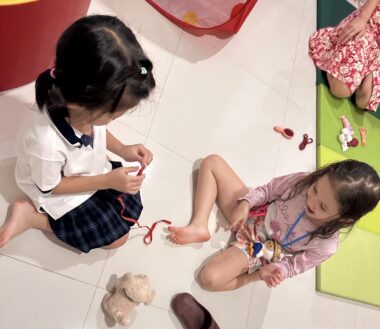Implementing the principles of universal design for learning
How UDL has benefited our daughter with AADC deficiency
Written by |

When my wife, Judy, became a certified special education teacher, we never imagined how crucial her expertise would become in our personal lives until our daughter, Rylae-Ann, was diagnosed with aromatic l-amino acid decarboxylase (AADC) deficiency, a rare neurotransmitter disorder.
Even with Judy’s background, we had a lot to learn. Five years ago, when Rylae-Ann was diagnosed, there was limited information about AADC deficiency, much less caregiving strategies. So we relied upon our knowledge as educators and sought advice from support groups, including families who were managing similar challenges, like cerebral palsy.
Initially, our strategies had little impact on Rylae-Ann’s development, but her smiles and laughter encouraged us to keep going. When she was 18 months old, she underwent gene therapy, a medical breakthrough that gave Judy’s training a chance to truly benefit our daughter.
We soon adopted the principles of universal design for learning (UDL), an educational framework aimed at making learning accessible to everyone. Developed by the Center for Applied Special Technology, now known simply as CAST, UDL promotes flexibility in teaching methods, materials, and assessments, helping educators to create lessons that meet students’ diverse needs.
Implementing UDL requires practice, and it has become our guiding philosophy. Its three core principles — multiple means of engagement, multiple means of representation, and multiple means of action and expression — have been essential in adapting our daily routines to support Rylae-Ann’s development.
Applying UDL
The UDL framework draws inspiration from universal design in architecture, which promotes spaces accessible to everyone. A ramp, for example, benefits not only those with mobility challenges but also anyone with a stroller or a person who prefers a gentler path. Similarly, UDL encourages adaptable environments where everyone can thrive. These principles guided us in turning everyday moments into meaningful opportunities for engagement and joy.
Here’s how it works for us:

Rylae-Ann, right, and a friend enjoy a play date that her parents planned with UDL principles in mind. (Photo by Richard E. Poulin III)
Multiple means of engagement: We provide Rylae-Ann with choices to foster independence and reduce anxiety. For family outings, we ensure activities are suited to her abilities, allowing her to engage comfortably. If she can’t join in a specific activity, there are still opportunities to socialize with friends or family.
At home, we tailor activities to her interests. Because she dislikes walking but loves riding on a bicycle, we took her trick-or-treating for Halloween in an adult tricycle rather than on foot. Playing her favorite songs during chores or daily routines helps her stay engaged, transforming everyday moments into positive experiences.
Multiple means of representation: Routines can be overwhelming for Rylae-Ann, so we break tasks into manageable steps. Instead of saying, “Go change your clothes,” we guide her through smaller tasks first, such as “Take off your pajamas.” Each completed step is met with praise — sometimes even a little dance to earn a giggle — before moving to the next one. This gradual approach builds her confidence and independence, one small victory at a time.
Multiple means of action and expression: We use adaptive tools, like Velcro shoes and easy-grasp utensils, to make routines less daunting. Allowing extra time for tasks also helps, as we acknowledge that her energy levels vary. When a task is too challenging, we pause and try again later, giving her the space to learn at her own pace.
The impact of UDL
Applying UDL principles has allowed us to create a more meaningful lifestyle for Rylae-Ann. By making thoughtful choices about engagement, representation, and expression, we’ve created an inclusive, empowering environment where she can thrive.
This framework supports inclusive learning in schools worldwide and has become our road map for family life. Integrating UDL into our routines has enabled us to build joyful memories and has brought us closer together on this journey. Each principle has given us tools to support Rylae-Ann’s growth, transforming routines into opportunities for connection and happiness.
Note: AADC News is strictly a news and information website about the disease. It does not provide medical advice, diagnosis, or treatment. This content is not intended to be a substitute for professional medical advice, diagnosis, or treatment. Always seek the advice of your physician or other qualified health provider with any questions you may have regarding a medical condition. Never disregard professional medical advice or delay in seeking it because of something you have read on this website. The opinions expressed in this column are not those of AADC News or its parent company, Bionews, and are intended to spark discussion about issues pertaining to aromatic l-amino acid decarboxylase deficiency.






Leave a comment
Fill in the required fields to post. Your email address will not be published.